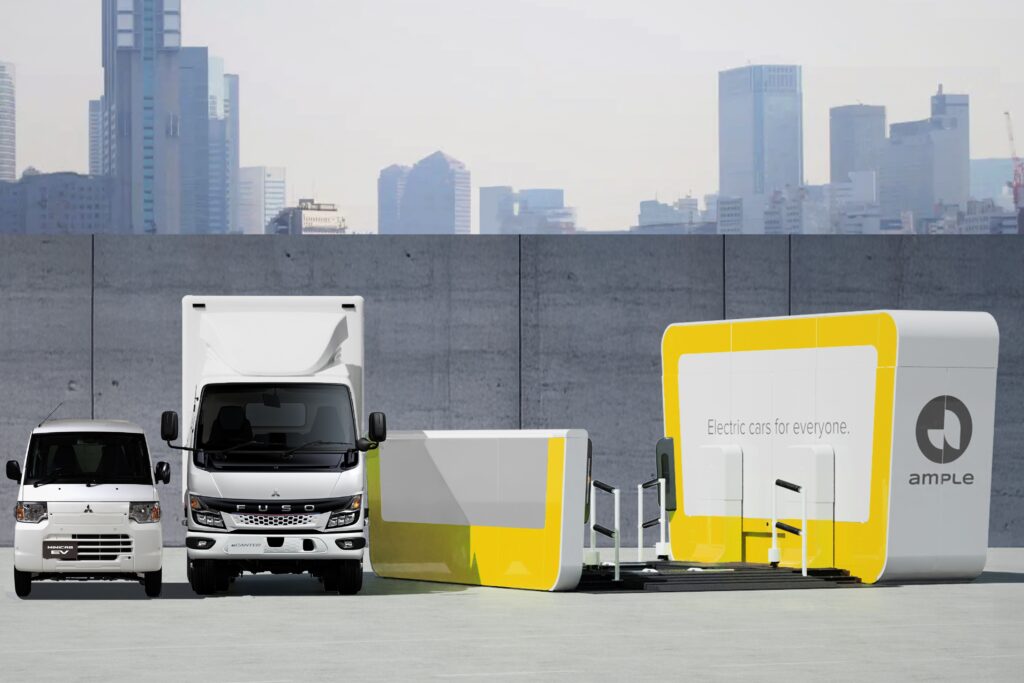As South Africa moves slowly but inexorably towards cleaner transport, Tokyo’s latest commercial EV (electric vehicle) battery-swapping pilot project could offer vital clues for solving local challenges. With load-shedding, grid constraints and rising fuel costs putting pressure on fleet operations, battery-swapping technology presents a compelling alternative to conventional charging. It’s fast, scalable and reduces downtime – making it especially relevant for South African cities where logistics and public transport must remain operational despite infrastructure volatility. A Tokyo-led initiative by Mitsubishi Fuso, Mitsubishi Motors, Ample and Yamato Transport is showing how urban fleets can electrify without compromise.
In September 2025, a major pilot project will launch in Tokyo to test battery-swappable electric vehicles across commercial delivery operations. The initiative will see over 150 swappable EVs deployed alongside 14 modular battery-swapping stations, all designed for high-utilisation urban fleet environments.
EVs included in the pilot range from Mitsubishi Fuso’s eCanter light-duty truck to Mitsubishi Motors’ Minicab EV (a kei-car class commercial vehicle widely used in Japan). Yamato Transport, the country’s largest logistics provider, will lead the vehicle deployment phase, focusing on last-mile delivery routes in dense city zones.
The pilot builds on earlier testing in Kyoto and has now scaled to become Tokyo’s largest battery-swapping commercial EV project to date. It is supported by the Tokyo Metropolitan Environment Public Corporation as part of a broader clean energy technology development programme.
Five-minute swaps to minimise downtime
Unlike conventional EV charging, which can immobilise commercial vehicles for long periods, the pilot’s swapping stations target a five-minute turnaround. Drivers never leave their cabs and vehicles are back on the road in minutes. This approach dramatically reduces downtime, boosts productivity and solves one of the biggest pain points in EV fleet adoption.
The swapping stations, designed by US-based Ample, are modular and rapidly deployable – a practical fit for high-density cities like Tokyo. The stations also have the potential to serve as grid-integrated infrastructure, storing renewable energy and supporting grid stability during peak loads.
Transport accounted for approximately 19% of Japan’s total CO₂ emissions in 2022. For the country to meet its 2030 climate target of a 46% emissions reduction (compared to 2013 levels) and reach carbon neutrality by 2050, commercial fleet electrification is critical. This project plays a direct role in supporting that transition, particularly in the logistics sector where operational uptime is non-negotiable.
Battery swapping not only supports these climate targets, but it also makes EV operations feasible for fleets with tight schedules and limited depot space. The technology enables zero-emission logistics without costly delays or infrastructure overhauls.
Open collaboration for future expansion
The Tokyo project is grounded in proven results. A prior demonstration in Kyoto in 2024 showed battery swapping could operate seamlessly across different vehicle types and brands. It also validated the system’s commercial value, with improved fleet uptime and charging convenience.
This new pilot expands on those results, bringing in new OEM participation and increasing both vehicle and infrastructure scale. Mitsubishi Motors’ involvement underscores growing industry alignment around swapping as a viable EV charging alternative for fleets.
The project remains open to additional manufacturers, logistics providers and technology partners. Its long-term aim is to build the foundation for a fully operational battery-swapping ecosystem in Tokyo – and beyond. As cities worldwide search for scalable EV solutions that work in real-world conditions, this pilot offers a blueprint for how smart infrastructure can meet commercial demands while supporting ambitious decarbonisation goals.
Editor’s note: For regions like Southern Africa, where grid challenges, urban density and logistics pressures mirror those of Tokyo, the lessons from this project could inform future mobility strategies – combining technology innovation with real-world practicality.
Ends




